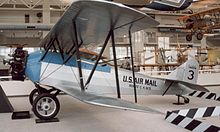| This article needs additional citations for verification. Please help improve this article by adding citations to reliable sources. Unsourced material may be challenged and removed. Find sources: "Varney Air Lines" – news · newspapers · books · scholar · JSTOR (April 2023) (Learn how and when to remove this message) |
 Swallow J-5 built 1924 with markings of CAM 5 as operated by Varney Airlines—displayed at the Museum of Flight, Boeing Field, Seattle, May 1989 Swallow J-5 built 1924 with markings of CAM 5 as operated by Varney Airlines—displayed at the Museum of Flight, Boeing Field, Seattle, May 1989 | |
| Commenced operations |
|
|---|---|
| Ceased operations |
|
| Operating bases | Boise, Idaho, United States |
| Parent company | United Airlines |
| Founder | Walter Varney |
Varney Air Lines was an American airline company that started service on April 6, 1926, as an airmail carrier. Formed by Walter Varney, the airline was based in Boise, Idaho, United States. The airline is one of the predecessors of United Airlines.
Historical background

In 1925, the Congress passed HR 7064 entitled "An Act to encourage commercial aviation and to authorize the Postmaster General to contract for Air Mail Service" (aka "The Kelly Act") which directed the U.S. Post Office Department to contract with private airlines to carry the mail over designated routes many of which connected with the Government operated Transcontinental Air Mail route between New York and San Francisco. Varney won the contract for CAM-5 as the only bidder. Its first flight under contract with the USPOD was from Pasco, Washington to Elko, Nevada with an intermediate stop in Boise. That air freight contract grew into the birth of one of the world's biggest airlines.
Pasco at the time was a rail center, more or less midway between Portland, Seattle, and Spokane. Mail trains leaving those cities in the evening arrived in Pasco early the next morning. Mail could be transferred to and from the biplanes cutting coast to coast delivery by days. This was the logic for basing the CAM service in Pasco.
First flight

Pilot Leon D. Cuddeback flew the first eastbound CAM-5 flight, leaving in the early dawn hours from Pasco. Between 4,000 and 6,000 cheering people sent the pilot off with 207 pounds (94 kg) of mail.
Later history
Varney added a Breese-Wilde Model 5 and replaced its original Swallows with Stearman C3s and thereafter upgraded as new equipment became available. Subsequent aircraft included the larger Stearman M-2 Speedmail and the Boeing Model 40 dedicated mail planes, and finally the more modern Boeing 247 twin-engine monoplane. Arriving in 1933, the 247 greatly expanded Varney's ability to carry passengers as well as mail.
Varney soon added Salt Lake City, Portland, and Seattle to its route.
In 1930, Varney was acquired by United Aircraft and Transport Corporation, itself formed by a merger of Boeing and Pratt & Whitney Aircraft, and folded into its airlines group along with the other acquired airlines: Pacific Air Transport, Boeing, and National Air Transport.
In 1934, the Air Mail scandal resulted in the passage of the Air Mail Act which forbade aircraft manufacturers from operating airlines. As a result, United Aircraft and Transport Corporation was broken up. The airlines group became United Airlines. Since Varney was a part of United, the founding year of United is 1926, and making United the oldest commercial airline in the United States.
Continental Airlines
Following cancellation of all domestic airmail contracts by the Roosevelt administration in 1934, Robert F. Six learned of an opportunity to buy into the Southwest Division of Varney Speed Lines which needed money to handle its newly acquired Pueblo-El Paso route. Six was introduced to Louis Mueller, who had helped found the Southwest Division of Varney in 1934, and bought into the airline with US$90,000 becoming general manager on July 5, 1936. The carrier was renamed Continental Air Lines (later changed to "Airlines") on July 8, 1937. Six changed the name to "Continental" because he wanted the airline name to reflect his desire to have the airline fly all directions throughout the United States. Decades later, in 2010, United (the direct successor to Varney) would merge with Continental as well.
See also
- List of companies based in Idaho
- List of defunct airlines of the United States
- Swan Island Municipal Airport
- United States airmail service
References
- Davies, R.E.G. (1998). Airlines of the United States since 1914. Smithsonian Institution Press. pp. 42–43. ISBN 1-888962-08-9.
- "30 Years Ago Idaho Was on First Airmail Route". Lewiston Morning Tribune. Associated Press. April 6, 1956. p. 11.
- "United Airlines Executive Air Traveller" (PDF). Delta Mike Airfield. Retrieved February 4, 2024.
- Brady, Tim (2000). The American Aviation Experience: A History. SIU Press. ISBN 9780809323715.
- Serling, Robert J. (1974). Maverick: The story of Robert Six and Continental Airlines. Doubleday & Company. ISBN 0-385-04057-1.
- Davies, R.E.G. (1984). Continental Airlines: the First Fifty Years, 1934–1984. Pioneer Publications.
- "Continental Facts". Continental. July 2009. Archived from the original on July 19, 2010. Retrieved February 8, 2010.
Further reading
- Tillman, Barrett (1971). "Six Million Miles: The Varney Airlines Story". Journal of the American Aviation Historical Society (Fall, Winter 1971).
External links
- Varney Lines newsletter, from The Museum of Flight Digital Collections
- Weekly News Letter (Varney Air Lines), from The Museum of Flight Digital Collections
- 1926 establishments in Idaho
- 1934 disestablishments in Idaho
- Airlines based in Idaho
- Airlines disestablished in 1934
- Airlines established in 1926
- American companies established in 1926
- American companies disestablished in 1934
- Companies based in Boise, Idaho
- Defunct airlines of the United States
- Defunct companies based in Idaho
- Transportation in Ada County, Idaho